ISSN ONLINE(2319-8753)PRINT(2347-6710)
ISSN ONLINE(2319-8753)PRINT(2347-6710)
Vaibhav S. kengar1,Sunil J Kadam1, Shamuvel V Pandit1, Mahesh.VIngale 2
|
| Related article at Pubmed, Scholar Google |
Visit for more related articles at International Journal of Innovative Research in Science, Engineering and Technology
A value stream is all the actions (both value added and non-value added) required to bring a product through the main flows essential to every product for the production flow from raw material into the arms of the customer and to design the flow from concept to launch as a lean manufacturing tool. Taking a value stream perspective means working on the big picture, not just individual processes and improving the whole not just optimizing the parts. Value stream mapping is a lean manufacturing technique and was first introduced as an independent methodology by Mike Rother and John Shook. Recording and mapping the processes to measure distances, times, number of workforce involved in the flow will further improve the productivity andquality of goods and service. It also reduces production lead time and WIP inventory. This paper describes the basic overview of manufacturing system performance improvement by VSM and the previous work carried by researchers along with brief review. It is possible to reduce lead time by reducing waste through proper scheduling, better team work, planning, training the workers and awareness in the workforce regarding the global competition. VSM is applicable to any kind of industry for performance improvement.
Keywords |
| Performance Improvement, Value Stream Mapping, lean manufacturing, Lead time. |
INTRODUCTION |
| A process is no more than the steps and decisions involved in the way work is accomplished. Even without Changing the process flow, speed can be injected into the system doing the away with the costs of waiting, and the resulting confusion by simply streamlining and debottlenecking the flow by reorganizing the flow of work. The current business environment has placed an increased focus on operational efficiencies while maintaining a high level of quality and innovation excellence [1]. With manufacturing becoming a more and more competitive market, companies globally strive to increase their efficiency. Value Stream mapping technique involves flowcharting the steps, activities, material flows, communications, and other process elements that are involved with a process or transformation. Companies are experiencing intense competitive pressure due to globalization hence they cannot afford to operate with waste in their processes [3]. A value stream is all the actions (value-added and non-value added) required to take a product from raw material to the customer, the design flow from concept to completion. Value-added activities are considered the actions and the process elements that accomplish those transformations and add value to the product from the perspective of the customer (e. g., tubing, stamping, welding, painting, etc.).Non-value-added activities are the process elements that do not add value to the product from the perspective of the customer such as setting up, waiting for materials and moving materials. |
| Previously many researchers have focused their studies of value stream techniques on food process industries, hospitals, textile industries and so on, but very few of them have focused on core study of production processes or continuous process sector industries. Presently authors are working performance improvement by Value Stream Mapping in medium scale foundry industry. The purpose of this paper is to highlight the effective utilization of the tool VSM for process and productivity improvement. |
VALUE STREAM MAPPING |
| Value Stream Mapping is an advanced form of process mapping.The philosophy includes the identification of target products or service and material flow pattern, then drawing on the shop floor a current state value stream map showing current steps, delays, information flows required to deliver the target product or service. Assessing the current state value stream in terms of creating flow by eliminating wastes. Once the current state is completed then future state value stream map is developed and work is carried out towards the future state implementation [3]. |
| A. Significance of Value Stream Mapping |
| 1. It helps to visualize more than just the single-process level, i.e. assembly, welding, etc., in production. The flow can be seen. |
| 2. It helps to see more than waste. Mapping helps to see the sources of waste in the value stream. |
| 3. It provides a common language for talking about manufacturing processes. |
| 4. It makes decisions about the flow apparent, so the brainstorming is possible. Otherwise, many details and decisions on the shop floor just happen by default. |
| 5. It ties together lean concepts and techniques, which helps to avoid “cherry picking”. |
| 6. It forms the basis of an implementation plan. By helping to design how the whole door-to-door flow should operate. For missing piece in so many lean efforts value stream maps become a blueprint for lean implementation. Imagine trying to build a house without a blueprint! |
| 7. It shows the linkage between the information flow and the material flow. No other tool does this. |
| 8. It is much more useful than quantitative tools and layout diagrams that produce a tally of non-value added steps, lead time, and distance travelled, the amount of inventory, and so on. |
| 9. Value stream mapping is a qualitative tool by which the detailed description of how the facility should operate in order to create a flow is perceived. |
| 10. Numbers are good for creating a sense of urgency or as before/after measures. Value stream mapping is good for describing what one can actually going to do to affect those numbers [3]. |
| B. Procedure for Mapping a Value Stream |
| Step 1: Identify the target product, product family, or service. |
| Step 2: Draw while on the shop floor a current state value stream map, which shows the current steps, delays, and information flows required to deliver the target productor service. This may be a production flow (raw materials to consumer) or informationflow. |
| Step 3: Assess the current state value stream map in terms of creating flow by eliminating waste. |
| Step 4: Draw a future state value stream map. |
| Step 5: Work toward the future state condition. |
| C. VSM Symbols |
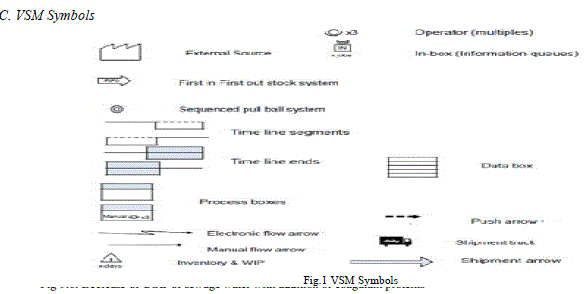 |
| D. The Seven Value Stream Mapping Tools |
| The typology of the seven new tools is presented in terms of the seven wastes already described. In addition the describing of the overall combined value stream structure will be useful and will also be combined as shown in the left hand column in tableI. Thus, in order to make improvements in the supply chain it is suggested here that at least an outline understanding of the particular wastes to be reduced must be gained before any mapping activity takes place [2]. |
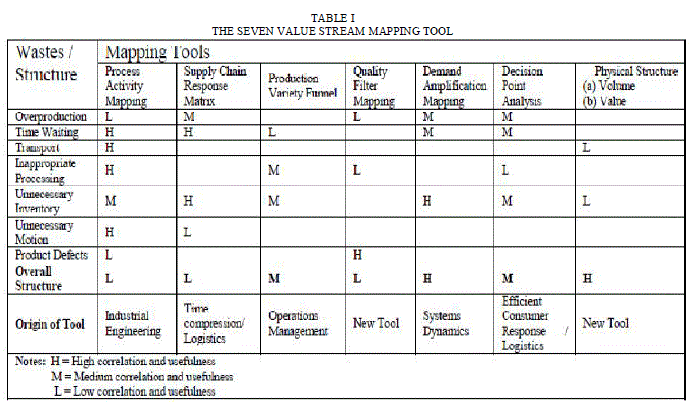 |
| At least two can be regarded as new, and others will be unfamiliar to a wide range of researchers and practitioners. Until now, however, there has been no decision support mechanism to help choose the most appropriate tool or tools to use. The tools themselves are drawn from a variety of origins as show in table 2. These origins include engineering (tools 1 and 5), action research/logistics (tools 2 and 6) operations management (tool 3), and two that are new (tools 4 and 7). As can be seen, they are generally from specific functional areas and so the full range of tools will not be familiar to many researchers, although specific tools may be well-known to individual readers. |
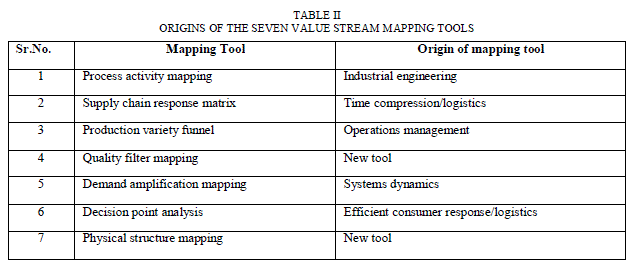 |
| E. VSM Measures |
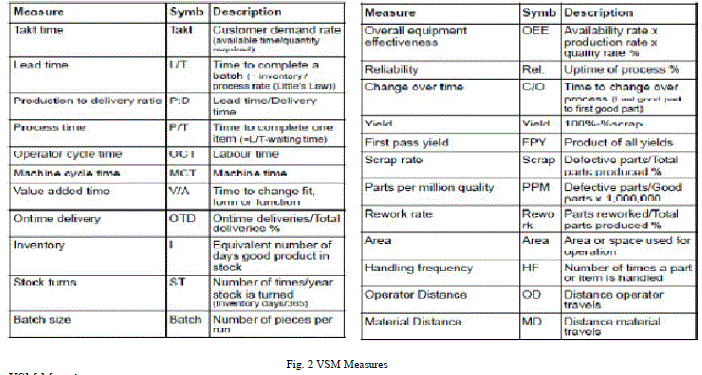 |
| F. VSM Mapping |
| 1. Current State Value Stream Map |
| All data for the current state map were collected according to the approach recommended by Rother and Shook. Data collection for the material flow started at the shipping department, and worked backward all the way to the CNC milling process, gathering snapshot data such as inventory levels before each process, process cycle times (CTs), number of workers, and changeover (CO) times. |
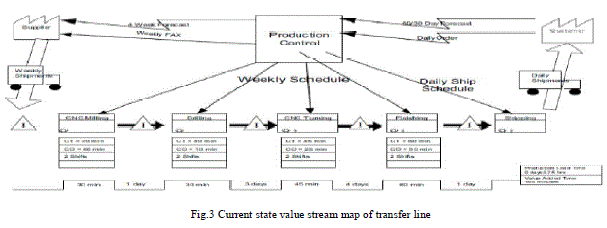 |
| 2. Future State Value Stream MAP |
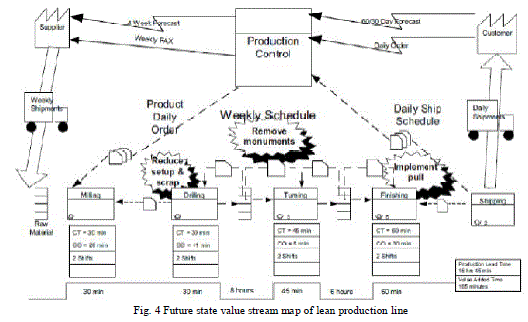 |
APPLICATION OF VSM FOR MANUFACTURING SYSTEM PERFORMANCE IMPROVEMENT |
| [1] (Consultas Pty Ltd. 2007) “Process Mapping & Procedure Development” |
| It looks simple, mainly because the considerable expertise in doing mapping is available. Mapping requires a process mindset, and process thinking, which is less common than one may think. Process mapping is a team effort and benefits from external facilitation. This ensures impartiality and provides focus to the team. Once the processes are mapped, then it is easy to train the people how to update them, so maintenance is easy and fully under the control. |
| [2] (Ibon Serrano Lasa, Carlos Ochoa Laburu, Rodolfo de Castro Vila 2008) “An evaluation of the value stream mapping tool” |
| The paper describes the methodology used is a case study of a company in which the process of application of the VSM has been thoroughly analyzed. A team created to improve the productive system of a manufacture for plastic casings for mobile phones has carried out this application.Nevertheless, there are some key points for the establishing teams that have to take into account, as follows: the time and training resources spent, the use of suitable information systems and a suitable management of the application phases.The conclusions of this research can be reinforced by the monitoring of the application process in more company cases. |
| [3](V. Ramesh, K.V. Sreenivasa Prasad, T.R. Srinivas 2008) “Implementation of a Lean Model for Carrying out Value Stream Mapping in a Manufacturing Industry” This paper explains how Value stream mapping helps an organization to identify the non-value-adding elements in a targeted process and brings a product or a group of products that use the same resources through the main flows, from raw material to the arms of customers. In this study, a practical study carried out in a manufacturing industry for the manufacture of Machining centre is discussed. The main aim was to draw the current state value stream mapping for the main components like Base, Column, Cross Slide, Milling Head and Table. It discusses the reduction in the set up time and cycle time that can be obtained through the implementation. This paper also discusses the plan of action for improving the Future State Value Stream Mapping (FVSM). A FVSM for the manufacture of Base is drawn. |
| [4] (Ulf K. Teichgraber, Maximilian de Bucourt 2010) “Applying value stream mapping techniques to eliminate nonvalue- added waste for the procurement of endovascular stents” Objectives: To eliminate non-value-adding (NVA) waste for the procurement of endovascular stents in interventional radiology services by applying value stream mapping (VSM). |
| Materials and methods: The Lean manufacturing technique was used to analyse the process of material and information flow currently required to direct endovascular stents from external suppliers to patients. Based on a decision point analysis for the procurement of stents in the hospital, a present state VSM was drawn. After assessment of the current status VSM and progressive elimination of unnecessary NVA waste, a future state VSM was drawn. Results: The current state VSM demonstrated that out of 13 processes for the procurement of stents only 2 processes were value-adding. Out of the NVA processes 5 processes were unnecessary NVA activities, which could be eliminated. The decision point analysis demonstrated that the procurement of stents was mainly a forecast driven push system. The future state VSM applies a pull inventory control system to trigger the movement of a unit after withdrawal by using a consignment stock. |
| [5] (Bhim Singh, Suresh K. Garg, and Surrender K. Sharma 2011) “Value stream mapping: literature review and implications for Indian industry” |
| VSM is different than conventional recording techniques, as it captures the information at individual stations about station cycle time, up time or utilization of resources, set-up time or change over time, work in process inventory, man power requirement and the information flow from raw material to finish goods. It covers both value adding as well as non-value-adding activities. This paper covers the review and classification of literature on VSM, as there is hardly any paper on literature review of VSM, so it will be very beneficiary for both academician and industry people. Applications of VSM are also presented by a case study of a small manufacturing Indian industry and reduction in lead time, processing time, work in process inventory and manpower requirement at individual stations are noticed. |
| [6] (SoundararajanKannan, Yanzhen Li, Naveed Ahmed, Zeid El-Akkad 2007) “Developing a Maintenance Value Stream Map” |
| This paper delineates that as a result of increasing focus on lean manufacturing in today’s competitive manufacturing environment, maintenance management has found a new vigor and purpose to increase equipment capacity and capability. Tremendous efforts have been put into in developing different types of maintenance strategies for enhancing the performance of the equipment but very little has been done in actually streamlining maintenance activities. This refers to systematically eliminating non-value added activities from the maintenance function. One of the primary lean manufacturing tools that can provide a different dimension in identifying and analysing non-value added activities is Value Stream Mapping (VSM). The purpose of this paper is to develop a VSM specifically for maintenance to evaluate the non-value added activities and provide recommendations to reduce the Mean Maintenance Lead Time (MMLT). |
| [7] (William M. Goriwondo, Samson Mhlanga, AlphonceMarecha2011) “Use of the value stream mapping tool for waste reduction in manufacturing-Case study for bread manufacturing in Zimbabwe” |
| Value Stream Mapping (VSM) is a World Class Manufacturing tool that can be used to minimize waste in manufacturing. This paper details the use of the VSM tool in reducing waste in bread manufacturing for a company in Zimbabwe. The case study shows how the VSM tool was used to identify and reduce defects by 20%, unnecessary inventory by 18% and motion by 37%. It incorporates waste relationship ranking and the importance of management commitment in waste reduction. |
CASE STUDY UNDER OBSERVATION |
| The time study for all the foundry operations was carried out for 45 days by using stopwatch as a recording technique. We have worked on casting defects for the bottleneck product rear wheel hubfor the month of March 2014 with quality department. We found the defects at primary inspection, secondary inspection and final inspection area which are presented in table III. Hence these is need to minimize casting defects for the targeted bottleneck product by application of Value Stream Mapping and improve the manufacturing system performance. |
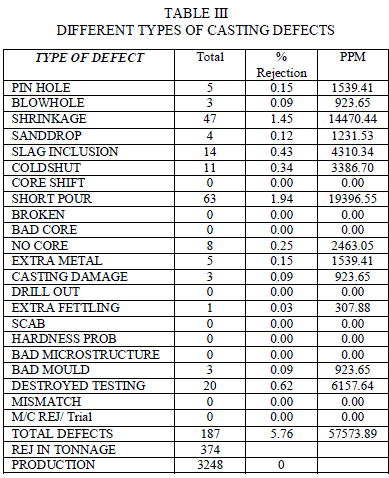 |
CONCLUSION |
| Value Stream Mapping (VSM) is a World Class Manufacturing tool that can be used to minimize waste in manufacturing. Companies are experiencing intense competitive pressure due to globalization hence they cannot afford to operate with waste in theirprocesses. The objective of this paper is to highlight some of the basic conceptsrelated to value stream mapping. The available literature is categorized as implementation procedure of VSM, VSMSymbols and VSM Measures, current state to future state map, VSM Tools and some previous work on VSM. Manufacturing system performance improvement by using all kinds ofVSM Tools is the key concern regarding the process and productivity improvement. |
References |
|